Last Updated on April 4, 2024
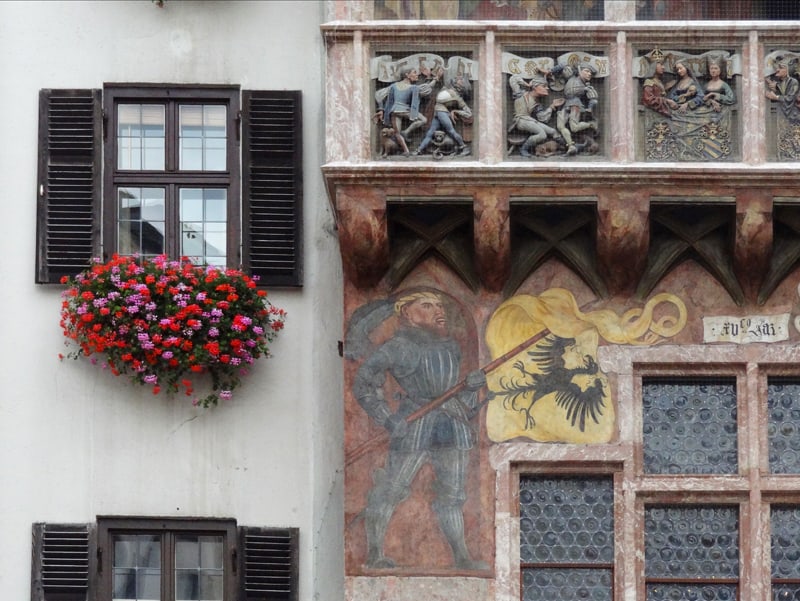
Unless you’re a skier, you might not have heard much about Innsbruck. But it’s worth a visit any time of year…
Estimated reading time: 13 minutes
By Jim Ferri
Skiers and hikers find many things to do in Innsbruck, Austria. I’m neither, although I do enjoy the mountains. But even though I’d made many visits to Alpine Europe and Austria’s Tyrol region for years, somehow I’d never been to Innsbruck.
Then one day, en route by rail from Switzerland to Italy, I decided to remedy the lapse. I changed my schedule and took the train to Innsbruck.
I booked a room in a hotel across from the train station. It was a good hotel, near the Altstadt, the old area of the city, which I wanted to explore.
Consequently, I didn’t need to get a taxi after my arrival by train.
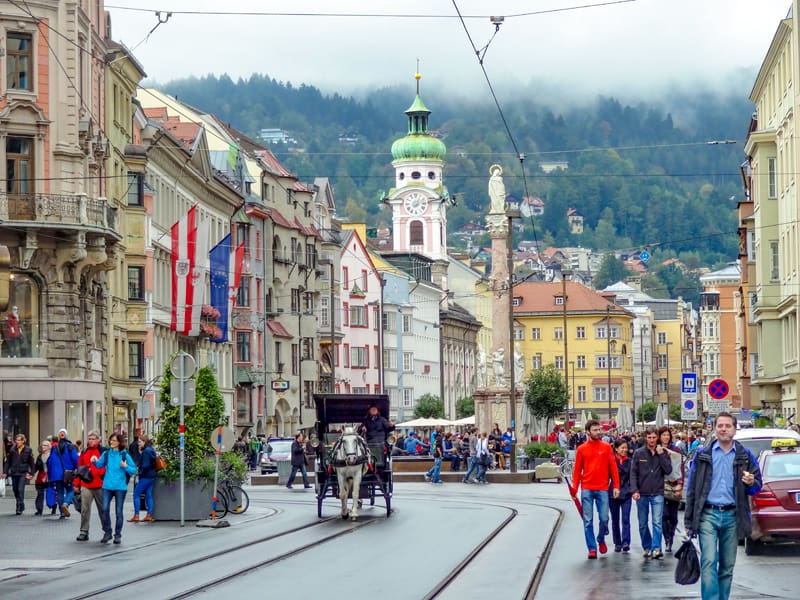
Innsbruck, Austria: A Colorful City
The first morning when I left the hotel to walk about the Altstadt, I was amazed I could clearly see the Tyrolean Alps that ringed the city.
Having been to many other Austrian and German cities, I was also surprised to see that buildings weren’t grayish and monochromatic as I expected. Instead, many were very colorful, and were various shades of yellow, green, rose and blue. One immediately senses Innsbruck’s appeal to travelers year-round.
I began my walk along Innsbruck’s Museum Strasse, up to Burggraben, one of the entrances into the old city. To my surprise I found a little flea market being set up right alongside the 16th century Gothic Hofkirche.
I made a mental note to return to it later, and headed into the Hofkirche. It’s the German Gothic church containing the cenotaph of Holy Roman Emperor Maximilian I.
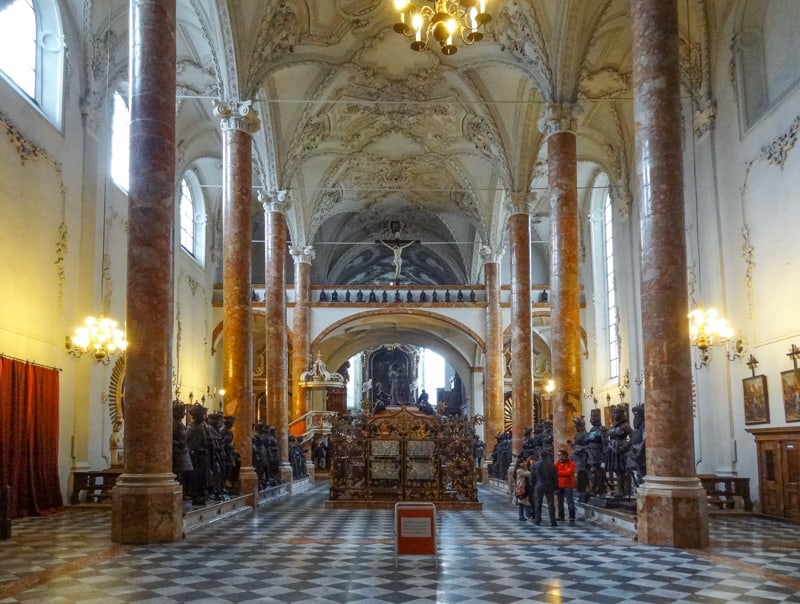
Visit the Hofkirche
Opening the massive wooden door of the 16th-century Hofkirche, I first thought I was there alone. Then I saw the caretaker, sitting at the top of the adjacent stairway eating an apple. He glanced over at me ever so briefly, before returning to his snack.
Standing in front of me, however, were 28 larger-than-life-size statutes flanking and guarding the tomb. The black bronze statues are of important historical figures of the time. No doubt they’re also the reason people call the church “Schwarzmanderkirche,” literally the “Black Men Church.”
The grandson of Emperor Maximilian I built as a memorial to him. Maximilian ‘s black marble tomb, intended to glorify the Holy Roman Empire, is one of Innsbruck’s notable works of art.
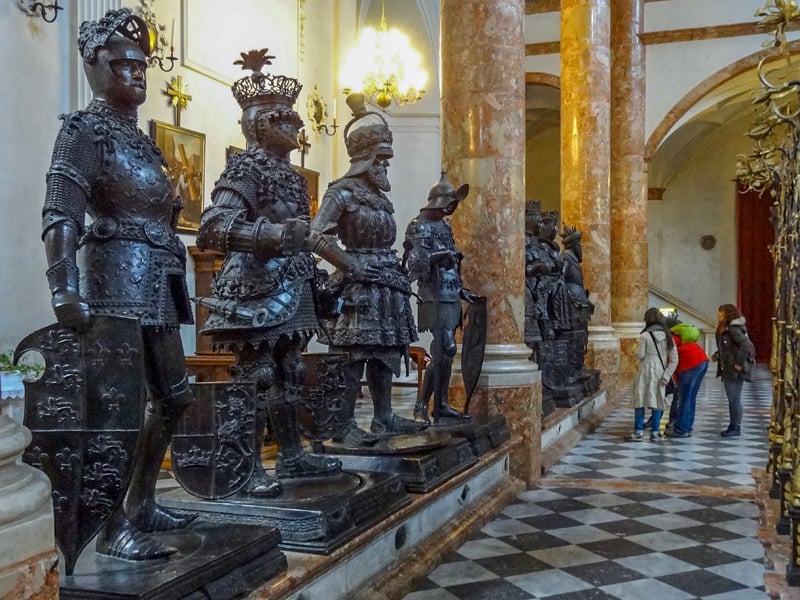
It’s a beautiful church with its formidable statues, towering red-marble columns, and a black marble tomb surrounded by ornate grillwork. There’s just one small issue…Maximillian isn’t in the tomb. His remains are not in the Hofkirche, but in the Castle of Wiener Neustadt near Vienna.
As I walked about the empty church, I noticed a sign asking visitors not to touch the statues. Continuing on, I saw the reason for the sign: the statue of Kaiser Rudolf von Habsburg, showing a well-endowed king, had the patina on that area totally rubbed off by passersby’s. If you travel to Innsbruck it’s well worth visiting.
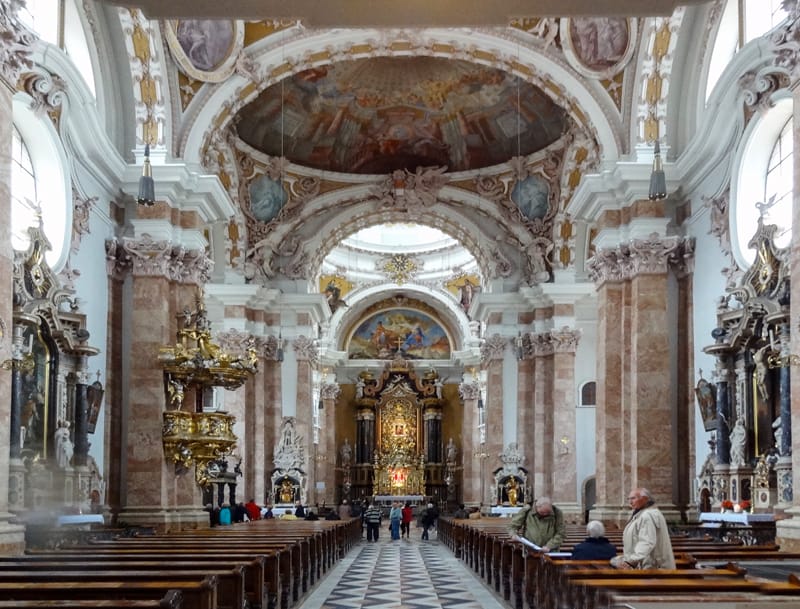
Innsbruck Cathedral
Also known as the Cathedral of St. James, or Dom zu St. Jakob in German, Innsbruck Cathedral is a magnificent Baroque church. Originally built in 1180, it was damaged by earthquakes in the 16th and 17th centuries, and rebuilt in the early 18th.
Only a three-minute walk from the Hofkirche, it’s an incredibly beautiful church. In addition to its beauty, people also come to the cathedral to hear the Innsbruck peace bells, rung at noon daily. There are 57 bells with a combined weight of over 4.5 tons. They are the largest in Austria.
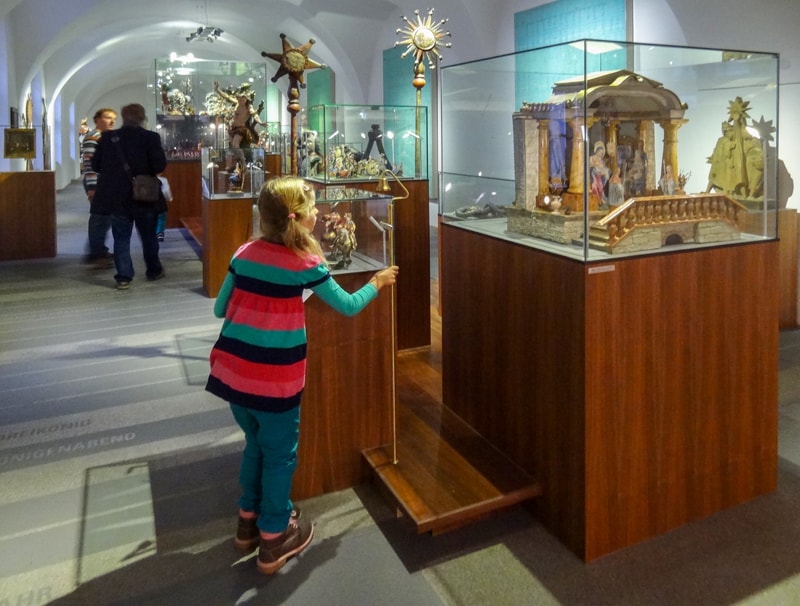
Tyrolean Folk Art Museum
If you enjoy folk art, backtrack to Innsbruck’s Hofkirche. Adjacent to it you’ll find the Tyrolean Folk Art Museum (Tiroler Volkskunstmuseum). First opened in 1888, it’s worth visiting since it provides an insight into all things Tyrolean.
Different zones in the museum show various aspects of the region’s culture. Some are aesthetically pleasing, other rather solemn, but all interesting.
One area, the “Gospel Miniatures,” documents the art of nativity-scene crib-making, beginning in the Baroque era. I found the workmanship exemplary. Another, “Illusion and Reality,” shows grand Tyrolean Festive costumes prior to the 20th century. All things considered, fashion and design students would likely love the place.
For me, however, the most interesting part of the museum is on its third floor. There you’ll find exhibits of beautiful folk furniture and interiors of old Tyrolean houses.
There are also dozens of life-size manikins showing how people of the time dressed, played, and interacted with one another. Just studying the faces is intriguing.
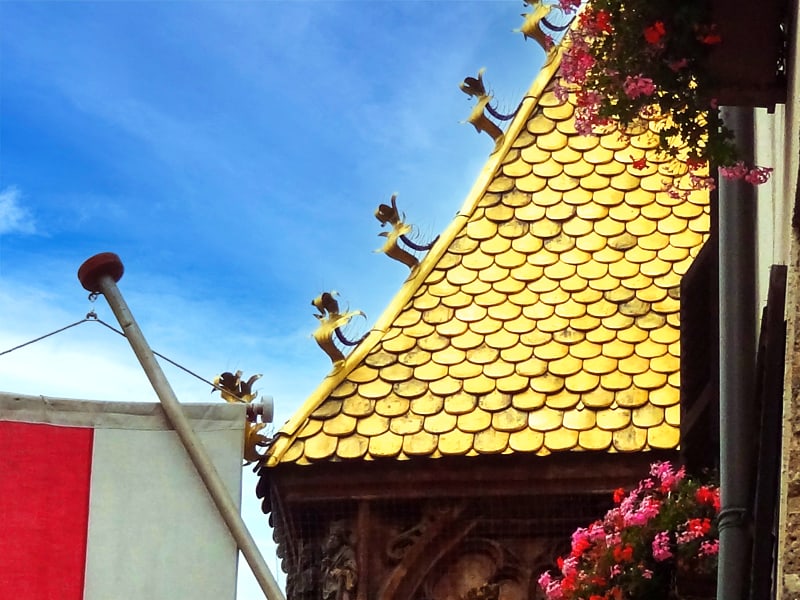
The Goldenes Dachl in Innsbruck
After the museum I walked back up the street to the much-hyped Museum Goldenes Dachl, in the heart of the historic center. The Goldenes Dachl (“Golden Roof”), a 52-foot-wide balcony, is the symbol of Innsbruck. It was built in 1500 by Emperor Maximilian I to celebrate his marriage. The building itself is from the 15th century.
It is most famous for the 2,657 golden tiles on its roof, hence the name. Maximilian had them installed because of rumors of imperial financial difficulties, which he wanted to quell.
The truth, however, is that the tiles aren’t gold, but fire-gilded copper tiles. Nevertheless, the world believed they demonstrated the wealth of Maximilian’s Empire.
The original roof tiles were replaced by copies in the 20th century. You can see six of the original tiles in the Golden Roof Museum.
I found it only mildly interesting, but you may like it if you’re interested in Austrian and European history.
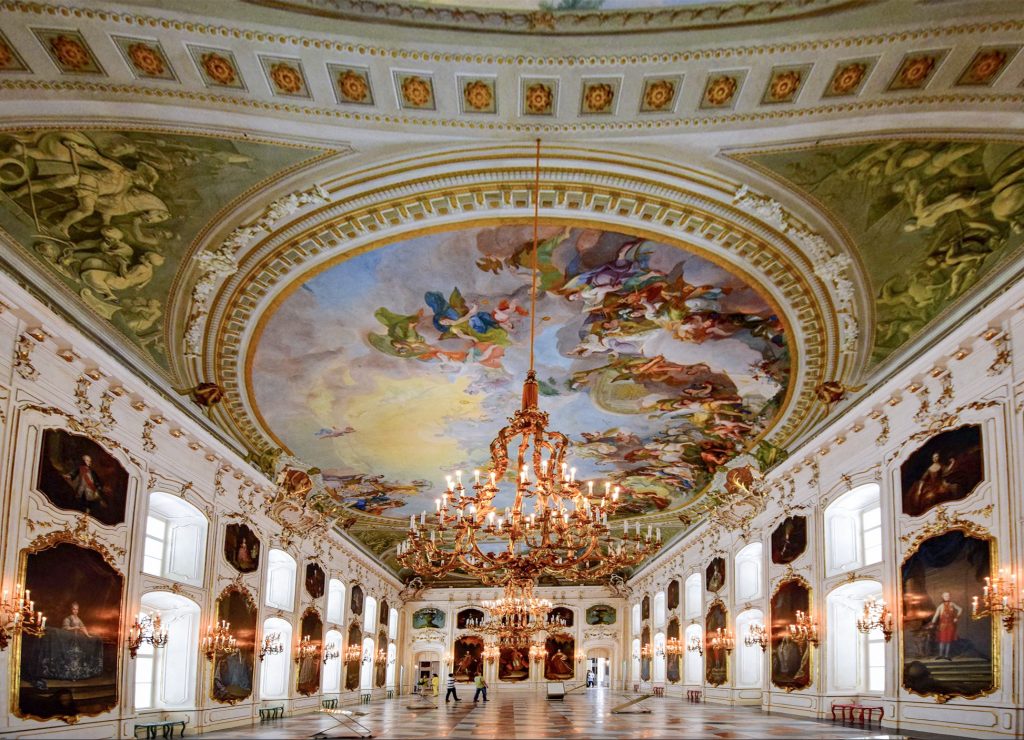
Innsbruck’s Hofburg Palace
Just a few steps from the Goldenes Dachl is Innsbruck’s Hofburg Palace, the former residence of Emperor Maximillian. Along with the Hofburg and Schönbrunn Palaces in Vienna, it’s one of the three most important historical buildings in Austria. And it’s one of the things to do if you’re visiting Innsbruck.
One enters this rococo palace through Giants Hall, so named because it once contained frescoes of Hercules. The frescos, however, are long gone.
Upon the death of Holy Roman Emperor Francis I, the frescos were covered by the Empress, Maria Teresa. In their places she installed paintings of her 16 children as a memorial to her husband.
The portraits you see today are of notable members of the Habsburg Dynasty. They encircle the opulent state room where three immense chandeliers hang beneath a beautiful painted ceiling. Around the room are several tables with tilt-able mirrors on them. Interestingly, you use them to view the ceilings without having to strain your neck all the time.
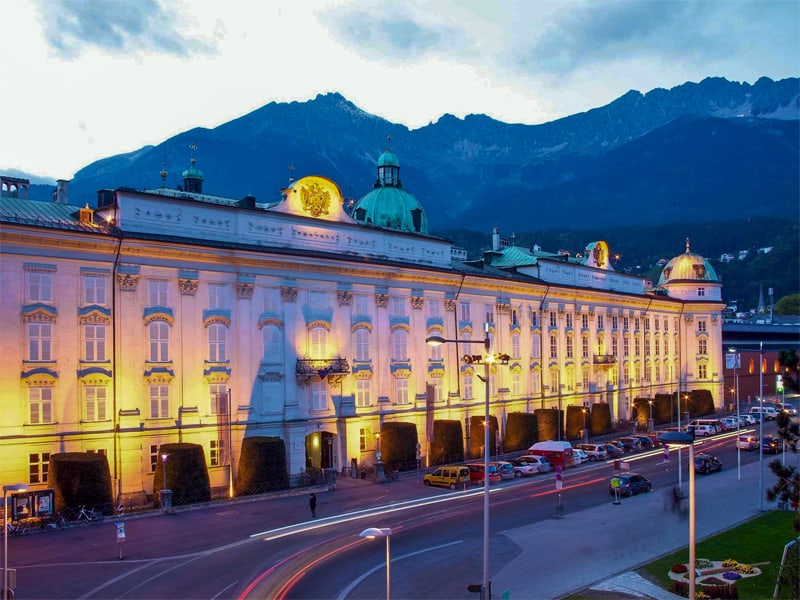
An Incredibly Beautiful Innsbruck Palace
As one would imagine, there are numerous rooms and apartments in this Innsbruck palace, also known as the Imperial Palace. Strolling through the rooms you can’t help but be overwhelmed by the beauty of the entire complex.
Each room in the private quarters are decorated in a different color. In the dining room, meals of 9 to 13 courses were served to the Empress and her guests.
Many of the exhibits emphasize chairs of different periods of the dynasties. But the palace was sparingly furnished except when the royal court assembled there. Then the royal furniture was transported to Innsbruck from Vienna.
In any case, that didn’t happen very often in Maria Teresa’s time, as she only visited the city twice in her lifetime.
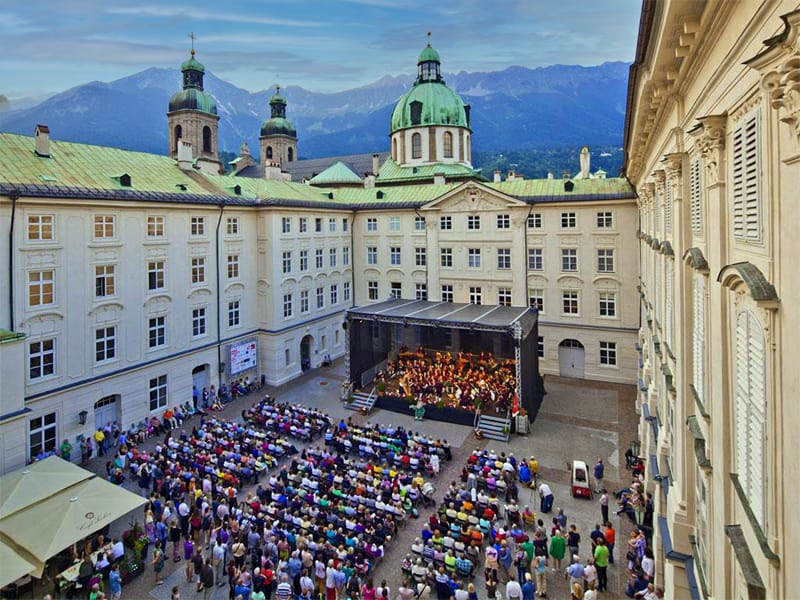
Like many attractions about the city, entrance to the palace is free with an Innsbruck Card, as is its audio guide,available for 24, 48 or 72 hours (adults € 55 / children € 27.50 for 48 hours), e.
After I left the Hofburg I went into the adjacent Café Sacher, the sibling of the renowned Vienna institution. Still in a regal mood after my tour of the palace, I was going to enjoy a Viennese coffee and a Sachertorte. I was just about to ask for a table but at the last moment decided I was more in the mood for something a bit less pretentious.
Consequently, I crossed the street to the Stiftskeller and ordered a dark beer and a plateful of sausage.
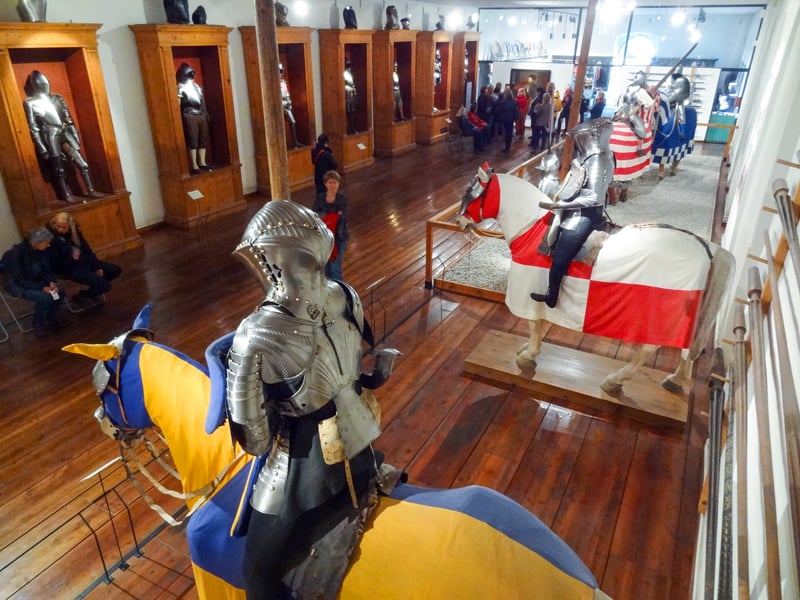
Don’t Miss 16th-century Renaissance Ambras Castle
While the Hofburg is in the center of the city, there’s also a fascinating castle on the city’s outskirts.
Ambras Castle is a 16th-century Renaissance masterpiece that was the home of Archduke Ferdinand II. All things considered, it’s a fascinating museum well worth the short trip. Visit it via the “The Sightseer,” Innsbruck’s hop-on/hop-off bus; the tram leaves you far away from the gate.
Ambras is quite large and is in two separate buildings. The first houses a Museum of art and “curiosities,” as they describe it. It includes an ancient arms museum with numerous suits of armor on soldiers standing in groups.
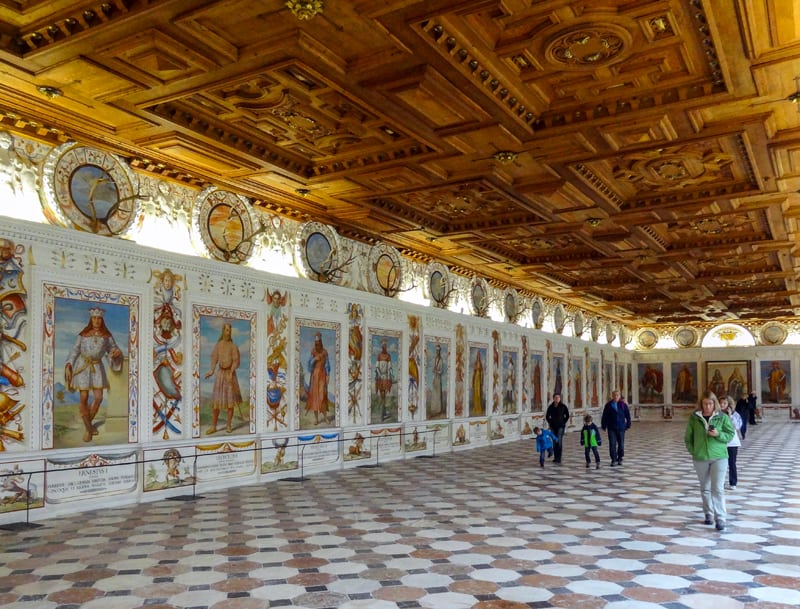
It gives one a real feel for what it must have been like in those times going into battle. Nearby are several knights on horseback. The rest of the building has numerous other displays, the “curiosities.”
The second building, just as interesting as the first, is mainly an art museum. It contains, among other things, portraits of the rulers of the Habsburg Empire. Plan on spending a half-day there.
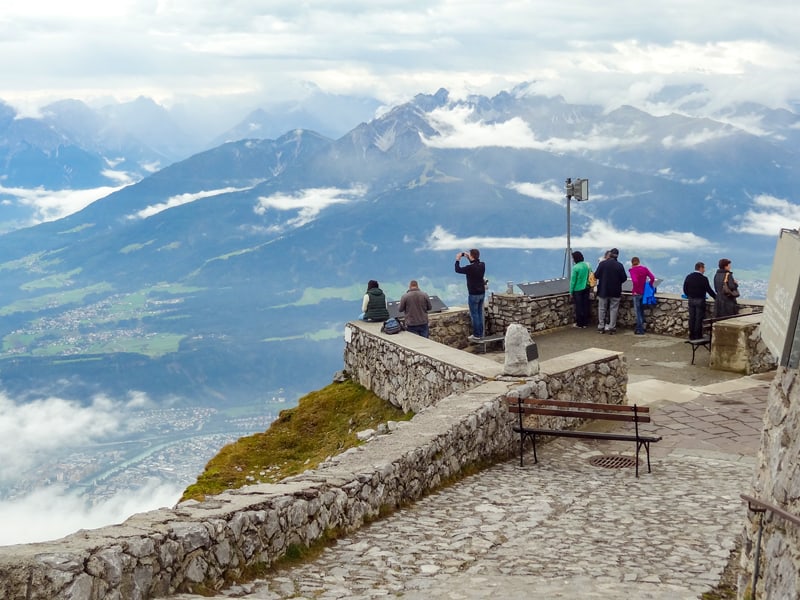
Go Up the Hafelekar, High Above Innsbruck
For another few hours you can enjoy a ride on the Nordkettenbahn, a cable car that goes to the peak of the 7400-foot high Hafelekar.
The ride is only 20 minutes and departs from a futuristic-looking station right in the old town just a short distance from the Hofburg. I had been told about it and found it even more worthwhile than I imagined.
Actually, from the station you travel up to Hafelekar in three stages. The first stage is in a car that runs on a track, making a few stops to drop off people in villages along the way. You then switch to cable car that takes you further up to where many hikers and some mountain climbers disembark.
You then continue all the way to the Hafelekar. At the top there is a fantastic view of the valley far below, and the mountains all about you.
In spite of being cloudy the day I went up, the view was beautiful since many of the clouds were below us and moving in and out every few minutes. It’s an easy and comfortable ride and one of the best cable-car rides in Europe.
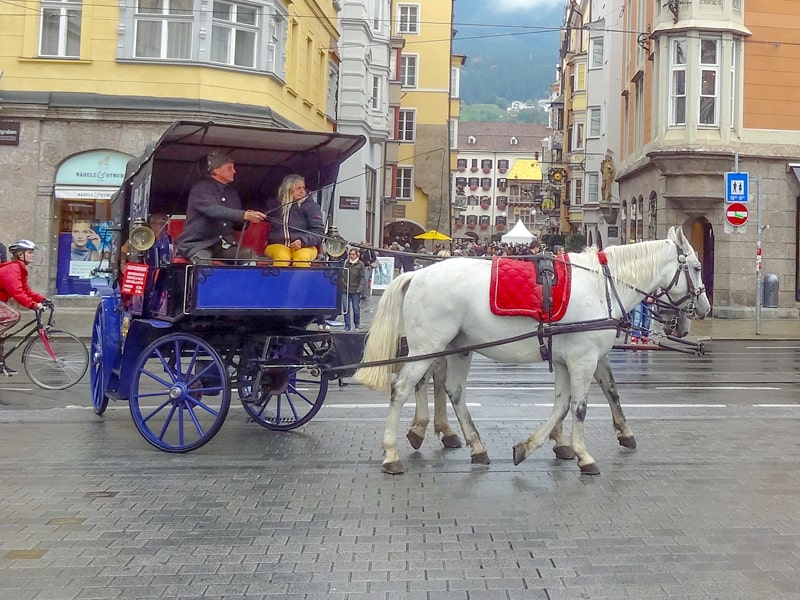
Wander and Enjoy the Beauty of the Innsbruck, Austria
While I enjoyed the various points of interest around the city – Hofburg and Ambras Castle, the Folk Museum and the Nordkettenbahn – most enjoyable was just wandering about, admiring the beauty of the city. You might also want to see part of the city in a horse-drawn carriage. Rates are usually €25 per half hour, €50 for a full hour.
By and large, the tourist center runs pretty much along Maria Theresien Strasse, the beautiful pedestrian shopping street. There you’ll find Rocco buildings, flowers tumbling from window boxes and a multitude of shops and restaurants. The entire area is always abuzz with activity.
In addition to its beautiful buildings, it’s even better known for its view northward to Nordkette. Walk southward and you’ll come to the Triumphforte, the triumphant arch built in 1756 for the marriage of Marie Therea’s son.
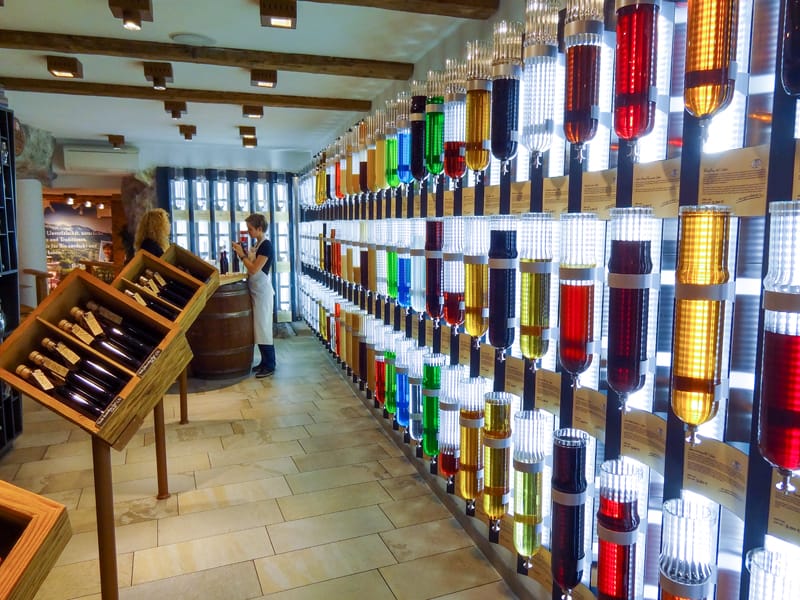
A Good Shopping City
A lane also abuzz is little Hofgasse, along which are the Goldenes Dachl, Hofburg, et al, as well as numerous shops. At number 3 is Speckeria, which does a good business selling “speck,” a special type of Tyrolean bacon, to groups of tourists.
Nearby, at number 5, is Tirol Geniessen, a store selling Tyrolean food, spirits, and syrups. On its walls are numerous different bottles of liqueurs and schnapps, each a different color depending on its contents. Stepping inside is like stepping into a rainbow.
Along Hofgasse and Maria Theresien Strasse you find all sorts of shops selling souvenirs of the city as well as sweaters and Tyrolean hats. And their customers aren’t just tourists. All around Innsbruck you’ll see men walking about wearing their traditional Tyrolean jackets and hats…just like they do up on the Hafelekar.
You may also enjoy: Hallstatt – the Prettiest Lakeside Village in Austria / Imperial Vienna Blooms In the Spring / Best Places to Visit in Europe – 9 Worth a Detour
If You Go:
Austrian Tourist Office
120 W 45th Street
New York, NY 10036
Tel: (212) 944-6880
Innsbruck Tourism
Burggraben 3
A-6021 Innsbruck
@ [email protected]
Tel: +43 512 / 53 56
Open: Daily 9am-5pm

Innsbruck is one of Austria’s little gems that does not get the respect of Vienna or Salzburg but is SO WORTH a few days! The Tyrolean people are robust and friendly; you always feel welcome. Thanks for bringing Innsbruck to the attention of your readers.
Thank you Donna. I really enjoyed Innsbruck. It’s a city that overlooked by too many travelers.